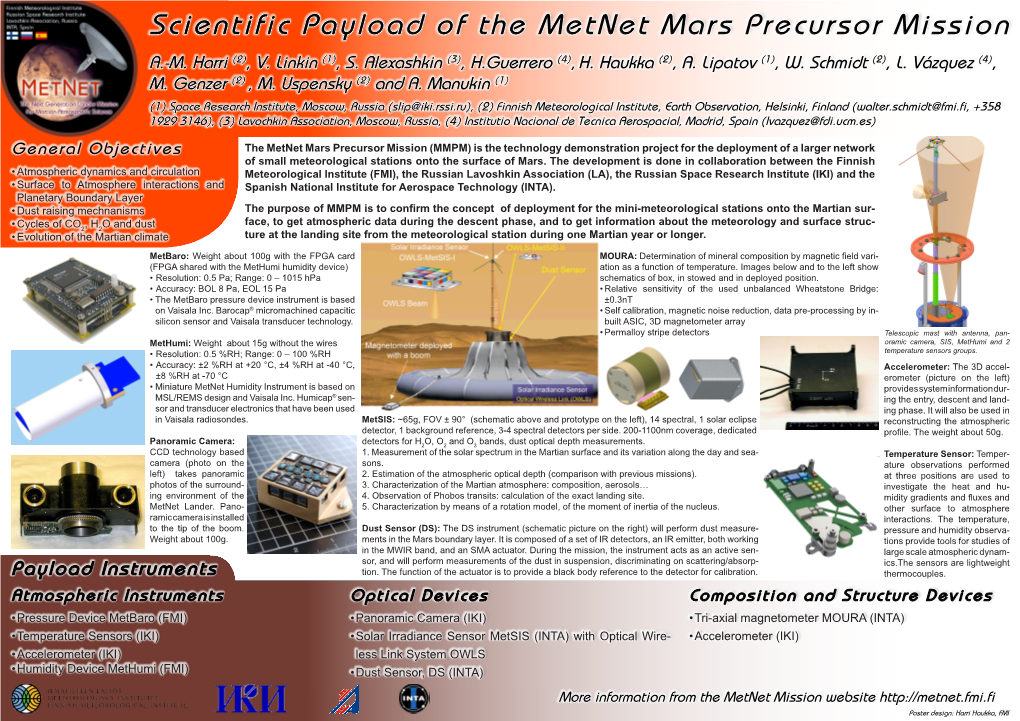Scientific Payload of the MetNet Mars Precursor Mission
A.-M. Harri (2), V. Linkin (1), S. Alexashkin (3), H.Guerrero (4), H. Haukka (2), A. Lipatov (1), W. Schmidt (2), L. Vázquez (4),
M. Genzer (2) , M. Uspensky (2) and A. Manukin (1)
(1) Space Research Institute, Moscow, Russia (slip@iki.rssi.ru), (2) Finnish Meteorological Institute, Earth Observation, Helsinki, Finland (walter.schmidt@fmi.fi, +358
1929 3146), (3) Lavochkin Association, Moscow, Russia, (4) Institutio Nacional de Tecnica Aerospacial, Madrid, Spain (lvazquez@fdi.ucm.es)
The MetNet Mars Precursor Mission (MMPM) is the technology demonstration project for the deployment of a larger network
General Objectives
•ꢀAtmospheric dynamics and circulation
•ꢀSurface to Atmosphere interactions and Planetary Boundary Layer of small meteorological stations onto the surface of Mars. The development is done in collaboration between the Finnish
Meteorological Institute (FMI), the Russian Lavoshkin Association (LA), the Russian Space Research Institute (IKI) and the Spanish National Institute for Aerospace Technology (INTA).
The purpose of MMPM is to confirm the concept of deployment for the mini-meteorological stations onto the Martian surface, to get atmospheric data during the descent phase, and to get information about the meteorology and surface structure at the landing site from the meteorological station during one Martian year or longer.
•ꢀDust raising mechnanisms
•ꢀCycles of CO2, H2O and dust
•ꢀEvolution of the Martian climate
MetBaro: Weight about 100g with the FPGA card MOURA:ꢀDeterminationꢀofꢀmineralꢀcompositionꢀbyꢀmagneticꢀfieldꢀvari-
(FPGA shared with the MetHumi humidity device)
•ꢀResolution: 0.5 Pa; Range: 0 – 1015 hPa
•ꢀAccuracy: BOL 8 Pa, EOL 15 Pa
•ꢀThe MetBaro pressure device instrument is based ±0.3nT on Vaisala Inc. Barocap® micromachined capacitic silicon sensor and Vaisala transducer technology.
ation as a function of temperature. Images below and to the left show schematics of box, in stowed and in deployed position.
•ꢀRelative sensitivity of the used unbalanced Wheatstone Bridge:
•ꢀSelf calibration, magnetic noise reduction, data pre-processing by inbuilt ASIC, 3D magnetometer array
•ꢀPermalloy stripe detectors
Telescopic mast with antenna, panoramic camera, SIS, MetHumi and 2 temperature sensors groups.
MetHumi: Weight about 15g without the wires
•ꢀResolution: 0.5 %RH; Range: 0 – 100 %RH
•ꢀAccuracy: ±2 %RH at +20 °C, ±4 %RH at -40 °C,
±8 %RH at -70 °C
•ꢀMiniature MetNet Humidity Instrument is based on
MSL/REMS design and Vaisala Inc. Humicap® sensor and transducer electronics that have been used in Vaisala radiosondes.
Accelerometer: The 3D accelerometer (picture on the left) providessysteminformationduring the entry, descent and landing phase. It will also be used in reconstructing the atmospheric profile.ꢀTheꢀweightꢀaboutꢀ50g.
MetSIS: ~65g, FOV ± 90° (schematic above and prototype on the left), 14 spectral, 1 solar eclipse detector, 1 background reference, 3-4 spectral detectors per side. 200-1100nm coverage, dedicated detectors for H2O, O2 and O3 bands, dust optical depth measurements.
1. Measurement of the solar spectrum in the Martian surface and its variation along the day and seasons.
2. Estimation of the atmospheric optical depth (comparison with previous missions).
3. Characterization of the Martian atmosphere: composition, aerosols…
4. Observation of Phobos transits: calculation of the exact landing site.
5. Characterization by means of a rotation model, of the moment of inertia of the nucleus.
Panoramic Camera:
CCD technology based camera (photo on the left) takes panoramic photos of the surrounding environment of the MetNet Lander. Panoramiccameraisinstalled to the tip of the boom.
Weight about 100g.
Temperature Sensor: Temperature observations performed at three positions are used to investigate the heat and humidityꢀgradientsꢀandꢀfluxesꢀandꢀ other surface to atmosphere interactions. The temperature, pressure and humidity observations provide tools for studies of large scale atmospheric dynamics.The sensors are lightweight thermocouples.
Dust Sensor (DS): The DS instrument (schematic picture on the right) will perform dust measurements in the Mars boundary layer. It is composed of a set of IR detectors, an IR emitter, both working in the MWIR band, and an SMA actuator. During the mission, the instrument acts as an active sensor, and will perform measurements of the dust in suspension, discriminating on scattering/absorption. The function of the actuator is to provide a black body reference to the detector for calibration.
Payload Instruments
Atmospheric Instruments Composition and Structure Devices
Optical Devices
•ꢀPressure Device MetBaro (FMI)
•ꢀTri-axial magnetometer MOURA (INTA)
•ꢀPanoramic Camera (IKI)
•ꢀTemperature Sensors (IKI) •ꢀAccelerometer (IKI)
•ꢀSolar Irradiance Sensor MetSIS (INTA) with Optical Wireless Link System OWLS
•ꢀAccelerometer (IKI)
•ꢀHumidity Device MetHumi (FMI)
•ꢀDust Sensor, DS (INTA)
More information from the MetNet Mission website
Poster design: Harri Haukka, FMI
Scientific Payload of the MetNet Mars Precursor Mission
